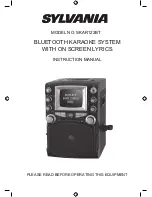
-11-
MAINTENANCE
1) To prolong the weld tip life and improve the weld quality, it is imperative that the weld tips and lower ground
bar always be kept clean. For best results, use a solvent to remove any built-up adhesive; a wire brush to
remove any galvanizing deposits; and a fine emory cloth to smooth the tip and ground bar surfaces.
2) When lower weld tip becomes worn in one area, loosen the locking cap screw and rotate the point of wear
away from the point of contact. Additional lower weld plates can be ordered from your local distributor.
3) Depending on usage and maintenance, the upper welding tip plate will have to be periodically replaced.Re-
placement weld tip plates can be ordered from your local distributor. To replace the upper weld tip, loosen
the locking cap screw and remove the weld tip. Remove the plate by loosening three (3) brass screws.
Throw away the screws and attach the new plate to the tip using the three brass screws supplied. Be
sure to align the angled section of the plate so it faces the feed mechanism. Then lock the tip in place.
Cycle the machine to check the feeding.
4) If feeding is erratic, re-adjust the upper weld tip height by loosening the lock nut on bottom of the dwell
cylinder shaft and then turning the dweld cylinder shaft clockwise to raise the tip; counter-clockwise to
lower the tip. Lock the tip in place with the locking nut.
OPERATIONS DISPLAY
The RH Mach III Pinspotters is provided with an OPERATIONS DISPLAY to help identify the source of the
problem should your pinspotter fail to perform properly. Watching these indicator lights will give you a clear
understanding of the electrical flow of the various circuits and components during use. Should a problem
arise, simply press the footswitch and watch to see which indicator fails to illuminate. A call to our Technical
Services Dept at 1-800-899-3876 will quickly identify the component to order, repair, or adjust.
STARTING OPERATION
1) Never actuate the unit without metal over the mandrel or lower copper ground bar. For maximum weld
quality, the metal should be in flat contact with the ground bar and mandrel. An adjacent table or roller on
which the sheet metal rests must be either exactly flush with, or slightly below, the top of the ground bar
and mandrel.
2) The WELD TIME knob controls the weld quality of the pinspotter. The display goes from 0 to 300. These
numbers are for reference only and have no relationship with actual time. It is recommended that an initial
setting of 150 be used and then adjust up or down accordingly in reference to the quality of welds.
Weld time is the length of time the welding transformers are on. A fraction of a second is generally all the
time needed for a quality weld. Unnecessary weld time not only wastes energy but can also burn up the
pins. (If the pins glow red up to the washer, the weld time is set too high.) Always set the weld timer to
the minimum time required for a good weld.
3) Before beginning production, always “pre-test” with smaller pieces of the same gauge sheet metal thickness
and the liner density you intend to use in the final production. The different densities and thicknesses of the
liner may require adjustments of the weld timer setting. For example: heavier gauge steel, thicker liner,
higher density liner and/or longer weld pins may require longer weld time. To make sure, always pre-test
any adjustment before you begin “final production.” However, only change the weld timer settings when a
change in the materials results in inefficient welding or a poor quality weld.






































